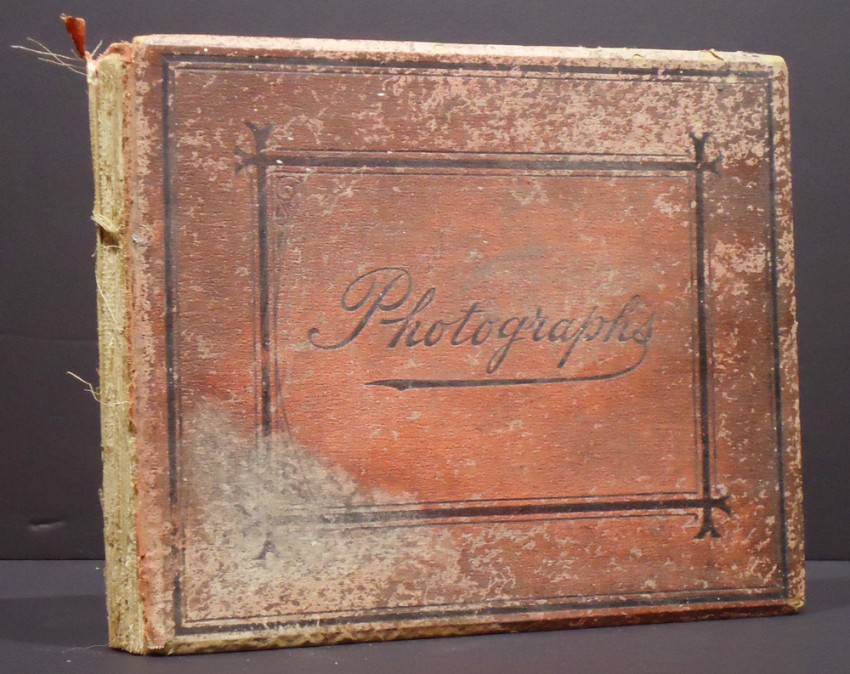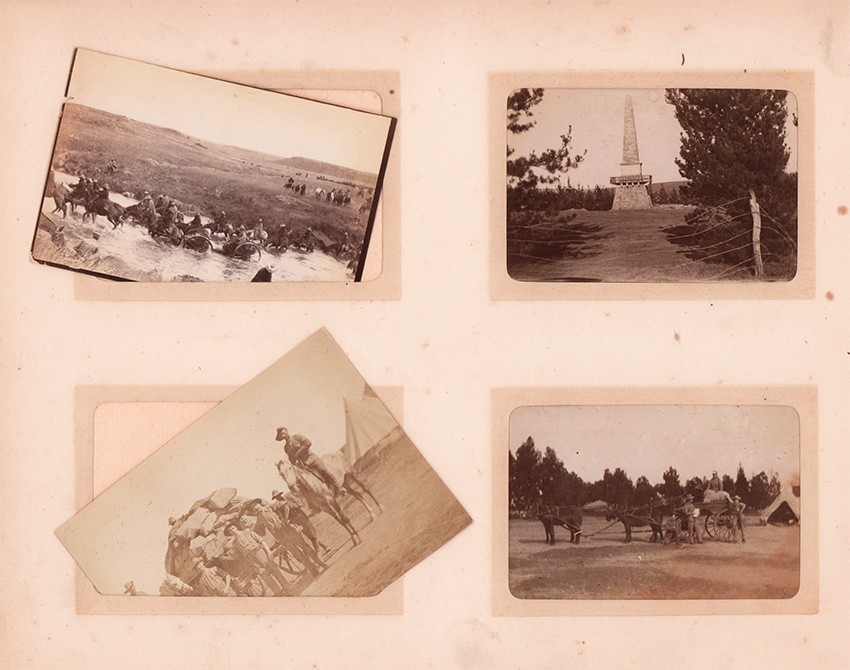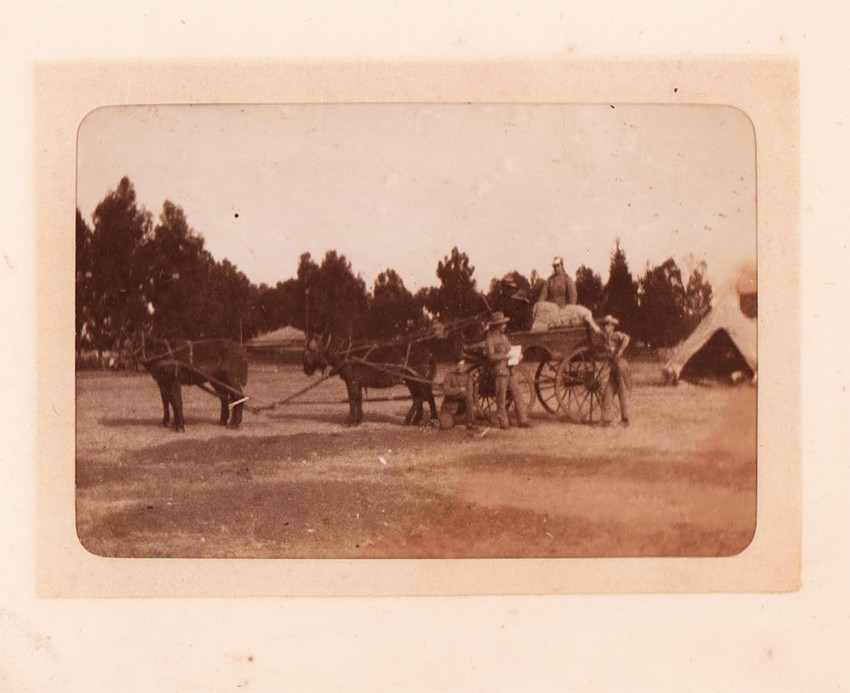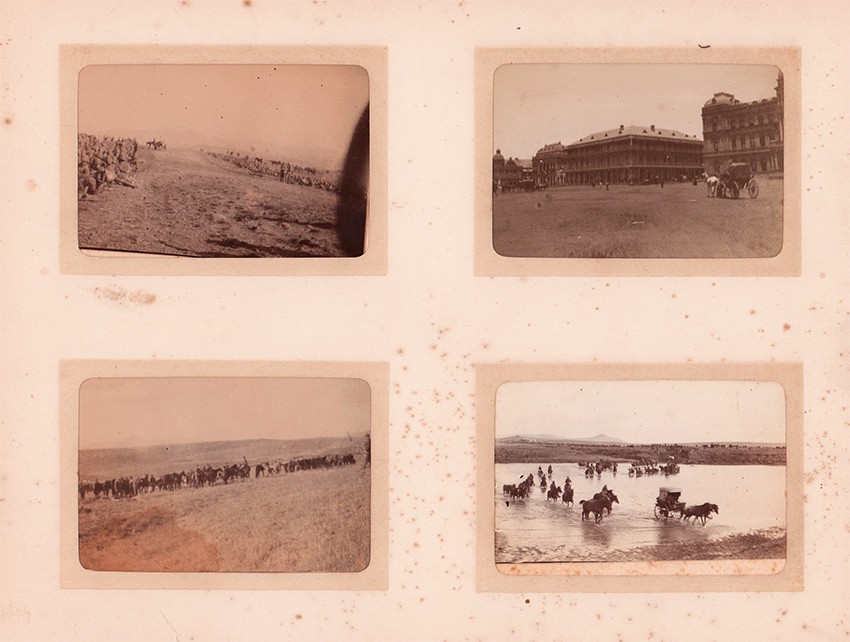319
Photograph Album. ANGLO BOER WAR Photograph album with the contents detached from its covers.
Photograph album with the contents detached from its covers. Original red cloth covers insect scarred with the word Photographs printed in black on the upper cover.
There are 25 unnumbered pages in the album containing 93 original Kodak photographs (6 x 8.5cm) - all sepia toned. The photographs have no captions and no dates - several have fallen out of their allotted spaces on each page. The photographs are in good condition and cover various aspects of the Boer War.
There are images which depict the following:
Troops crossing rivers Cannons in various positions
Provisions being transported by wagons
Churches, farm houses, settlements, a tented camp
Tombstones
Ships in Table Bay
Numerous photographs of officers
There is one larger photograph (11 x13cm) loosely inserted with the caption on the back March 17 1907 St. Patricks Day Hout Bay depicting a group of soldiers.
Military History Journal vol. 16 no 1 June 2013: With the invention of the half-tone process in the 1880s came the ability to reproduce photographs directly in print media. Fast on the heels of this printing revolution, in 1888, came the launch of Kodak's box camera, which used rolled paper film, and made the art of photography accessible (at a price) to all.
Specifically aimed at the amateur market, Kodak's cameras meant that at the outbreak of the Anglo-Boer War of 1899 -1902 many soldiers possessed cameras and used them freely at any opportunity. Coupled with a large number of professional photographers, commissioned by specialist magazines such [as]Black and White Budget or Navy and Army Illustrated, the number of cameras in that theatre of war means that there are today many more photographs from the Anglo-Boer War than from the Anglo-Zulu War of just twenty years earlier.
Indeed, the sheer number of photographers unfortunately means that many of their names are sadly now lost to history. Importantly, however, the reproduction of their photographs in print means that the historic images they took have fortunately survived.
The proliferation of photographic equipment near or even at the front line led to a number of early 'action' photographs being taken during the Anglo-Boer War. But still most photographers tended to capture largely posed subjects and static scenes. This perhaps limits the dramatic effect of such photographs to modern eyes, but it brings one major advantage: it is often possible to identify the precise spot at which the photographer stood while pointing his lens at a battlefield, and compare the scene he saw then with that same location today. This 'then and now' comparison can be further enhanced through the use of photographic software, which enables the historic and current day views to be superimposed to produce a 'blended' photograph that provides a window on a lost world. http://samilitaryhistory.org/vol161sm.html
For further details and and to bid visit AntiquarianAuctions.com
Photograph album with the contents detached from its covers. Original red cloth covers insect scarred with the word Photographs printed in black on the upper cover.
There are 25 unnumbered pages in the album containing 93 original Kodak photographs (6 x 8.5cm) - all sepia toned. The photographs have no captions and no dates - several have fallen out of their allotted spaces on each page. The photographs are in good condition and cover various aspects of the Boer War.
There are images which depict the following:
Troops crossing rivers Cannons in various positions
Provisions being transported by wagons
Churches, farm houses, settlements, a tented camp
Tombstones
Ships in Table Bay
Numerous photographs of officers
There is one larger photograph (11 x13cm) loosely inserted with the caption on the back March 17 1907 St. Patricks Day Hout Bay depicting a group of soldiers.
Military History Journal vol. 16 no 1 June 2013: With the invention of the half-tone process in the 1880s came the ability to reproduce photographs directly in print media. Fast on the heels of this printing revolution, in 1888, came the launch of Kodak's box camera, which used rolled paper film, and made the art of photography accessible (at a price) to all.
Specifically aimed at the amateur market, Kodak's cameras meant that at the outbreak of the Anglo-Boer War of 1899 -1902 many soldiers possessed cameras and used them freely at any opportunity. Coupled with a large number of professional photographers, commissioned by specialist magazines such [as]Black and White Budget or Navy and Army Illustrated, the number of cameras in that theatre of war means that there are today many more photographs from the Anglo-Boer War than from the Anglo-Zulu War of just twenty years earlier.
Indeed, the sheer number of photographers unfortunately means that many of their names are sadly now lost to history. Importantly, however, the reproduction of their photographs in print means that the historic images they took have fortunately survived.
The proliferation of photographic equipment near or even at the front line led to a number of early 'action' photographs being taken during the Anglo-Boer War. But still most photographers tended to capture largely posed subjects and static scenes. This perhaps limits the dramatic effect of such photographs to modern eyes, but it brings one major advantage: it is often possible to identify the precise spot at which the photographer stood while pointing his lens at a battlefield, and compare the scene he saw then with that same location today. This 'then and now' comparison can be further enhanced through the use of photographic software, which enables the historic and current day views to be superimposed to produce a 'blended' photograph that provides a window on a lost world. http://samilitaryhistory.org/vol161sm.html
For further details and and to bid visit AntiquarianAuctions.com
Online Rare Books, Maps & Prints and Photography Auction
Sale Date(s)
Venue Address
General delivery information available from the auctioneer
Registration on AntiquarianAuctions.com is free of charge.
As a successful bidder you will receive an invoice from the seller after the auction. The seller will only invoice the final selling price. We do not charge a buyer’s premium and no VAT applies.
The buyer pays for shipping and insurance costs which can be requested from the seller before the end of the sale.
Important Information
This is an online only auction. Please visit AntiquarianAuctions.com for further information about a lot and to bid.
Terms & Conditions
There is no buyer’s premium charged on AntiquarianAuctions.com
AntiquarianAuctions.com is an online rare book auction website. All lots are listed by recognised booksellers who have been vetted before being accepted to sell on the site. This allows buyers to bid with confidence and ensures that lots are accurately described.
Bidding will begin on 18 April at 5.30 pm (UK time) and ends on 25 April at 5.30 pm (UK time). Please follow the countdown on AntiquarianAuctions.com.
Please visit AntiquarianAuctions.com for further information about a lot and to bid












